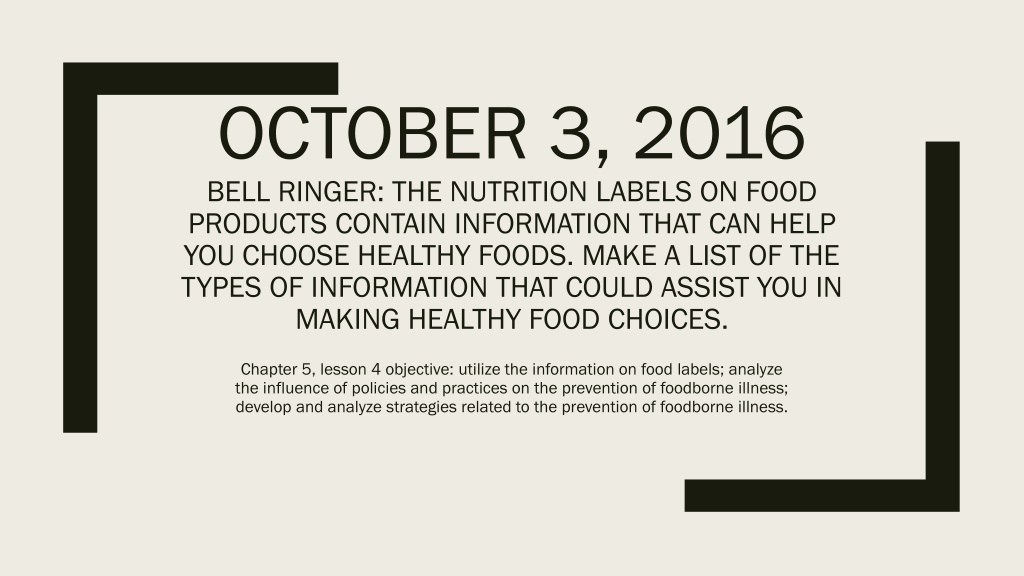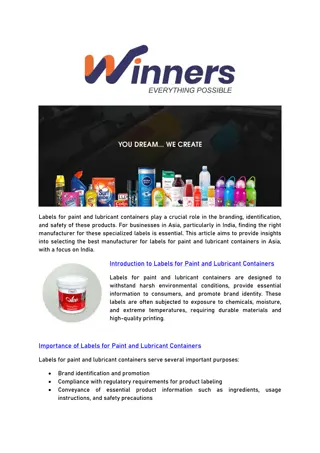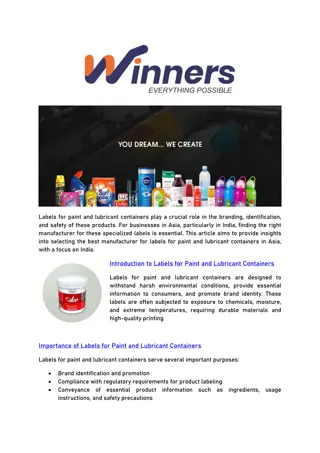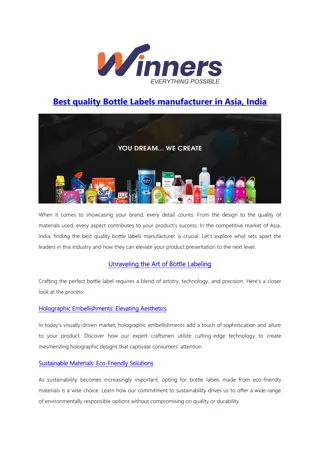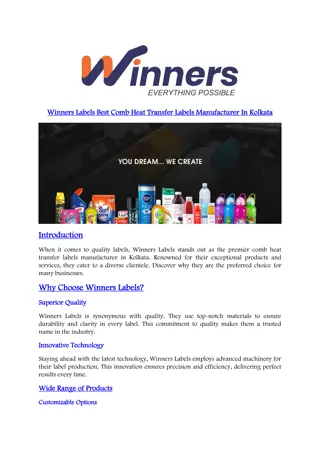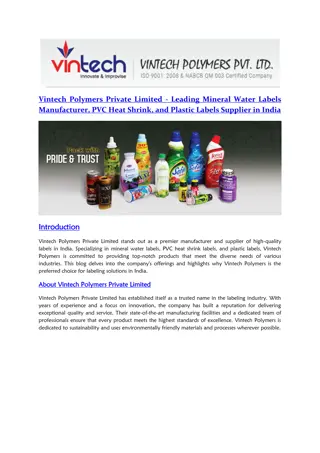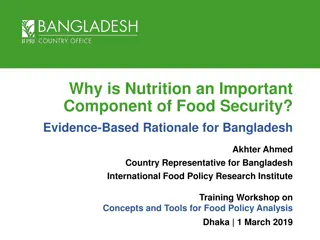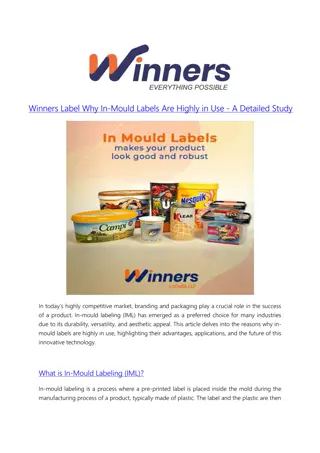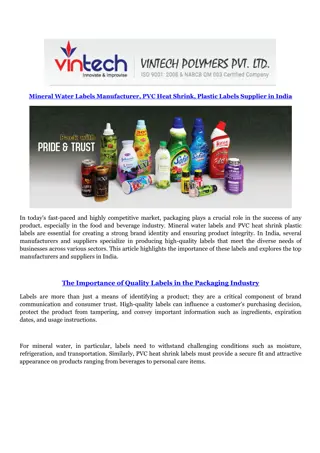Understanding Nutrition Labels and Food Safety Practices
Explore the essential information found on food labels to make informed decisions about your diet, while also delving into the importance of food safety practices to prevent foodborne illnesses. Understand the significance of ingredients lists, sugar and fat substitutes, and how to interpret expiration dates. Familiarize yourself with key terms like food additives, food allergies, food intolerance, and more to enhance your knowledge about food consumption.
Download Presentation

Please find below an Image/Link to download the presentation.
The content on the website is provided AS IS for your information and personal use only. It may not be sold, licensed, or shared on other websites without obtaining consent from the author. Download presentation by click this link. If you encounter any issues during the download, it is possible that the publisher has removed the file from their server.
E N D
Presentation Transcript
OCTOBER 3, 2016 BELL RINGER: THE NUTRITION LABELS ON FOOD PRODUCTS CONTAIN INFORMATION THAT CAN HELP YOU CHOOSE HEALTHY FOODS. MAKE A LIST OF THE TYPES OF INFORMATION THAT COULD ASSIST YOU IN MAKING HEALTHY FOOD CHOICES. Chapter 5, lesson 4 objective: utilize the information on food labels; analyze the influence of policies and practices on the prevention of foodborne illness; develop and analyze strategies related to the prevention of foodborne illness.
Words to know Food additives: substances intentionally added to food to produce a desired effect Food allergy: condition in which the body s immune system reacts to substances in some foods Food intolerance: negative reaction to a food or part of food caused by a metabolic problem such as inability to digest parts of certain foods or food components Foodborne illness: food poisoning Pasteurization- process of treating a substance with heat to destroy or slow the growth of pathogens Cross-contamination: spreading of bacteria or other pathogens from one food to another
Nutrition labeling Examine almost any food package, and you ll find this image on it. The law requires that these information panels be placed on packages of food that are intended for sale. Which information is on the actual Which information is on the actual product but NOT on the nutrition product but NOT on the nutrition facts? facts? Expiration date Expiration date
Ingredients list Most food labels also list the foods ingredients by weight, in descending order, with the ingredient in the greatest amount listed first. However, food labels that list several similar ingredients can be confusing. Ex, when three sweeteners honey, sugar and corn syrup- are used in the product, each is listed separately; therefore, they appear lower on the list than they would if they were counted as one ingredient sugars. this MAY give the impression that the product contains less sugar than it really does!
Sugar and fat substitutes The food industry has developed a number of substitutes for sugar and fat, mainly because the public has spoken on the concern of excess calories in food! Many diet drinks, for example, are sweetened with aspartame, whish is essentially calorie free. Fructose, the natural sugar in fruit, is sometimes used as a sweetener. Because fructose is sweeter than table sugar, less sweetener is needed and fewer calories are added to the food. Some potato chips are made with fat replacers so that they supply few calories from fat. An example of a fat replacer is olestra, which passes through the body undigested. Because it is not absorbed, some find that its consumption can produce gastrointestinal problems such as diarrhea.
Product Labeling Along with nutrition information, food labels may state the potential health benefits of a food. In some cases the label also details the conditions under which the food was produced or grown ex, is the food organic/contains organic ingredients NUTRITION CONTENT CLAIMS: Product labels may advertise a food s nutrient value. Claims such as 100% Fat-Free or Light in Sodium describe the nutrient content of food. Light or Lite: calories have been reduced by at least one-third or the fat or sodium has been reduced by at least 50%. Less: the food contains 25% less of a nutrient or of calories than comparable food Free: food contains no amount, or an insignificant amount of total fat More: the food contains 10% more of the Daily value for a vitamin, mineral, protein or fiber High/Rich in/Excellent Source of- food contains 20% or more of the vitamin, mineral protein or fiber Lean: the food is a meat, fish or shellfish product that has less than 10gm of total fat, and less than 95 mg of cholesterol per 3-ounce servings
Open dating Many food products have OPEN DATES on their labels. The open dates on products such as milk and canned goods reflect their freshness. Canned foods eaten after these dates are safe, but they may not taste as fresh (Mrs. Curry will NOT drink milk even on the day it says its gone bad) What are some items you won t eat or drink if you see the expiration has gone out? Open dates on food such as meat can help you make decisions about the foods safety. expiration date: the last date you should use the product freshness date: the last date a food is considered to be fresh pack date: the date on which food was packaged sell-by date (or pull date): the last date the product should be sold. You can store and use a product after its sell-by date
Food sensitivity- do you know anyone who feels ill after eating certain foods? Food allergy is a condition in which the body s immune system reacts to substances in some foods. These substance are called allergens, which are proteins that the body responds to as if they were pathogens, or foreign invaders. Allergies to peanuts, tree nuts, eggs, wheat, soy, fish and shellfish are most common. Scratch tests, in which tiny amounts of suspected allergens are injected under the skin, are the most common test for allergies. Blood tests can also indicate whether a person is allergic to a specific food. People with allergies have different types of allergic reactions. These m ay include rash, hives, or itchiness of the skin, vomiting, diarrhea or abdominal pain, itchy eyes and sneezing.
Foodborne illness You have seen the signs in restaurants restrooms: Employees must wash their hands before returning to work. restaurants have this policy because handwashing after using the restroom is one strategy to prevent foodborne illness. This may result from eating food contaminated with pathogens (disease-causing organisms) the poisons they produce, or poisonous chemicals. Many times the contaminant cant be seen, smelled or tasted. The best way to protect yourself is to become knowledgeable about the causes of such illnesses and ways to keep food safe.
Did you know Lactose Intolerance, the inability or reduced ability to digest the natural sugar in milk, is a manageable condition. Small amounts of milk consumed more frequently may be easier to digest. Drinking milk with food helps too. Another option to get milk s nutrients from yogurt or cheese, which usually don t cause a problem. Health care professionals can explain how to use them. Also, lactose-reduced milk and other products containing the same nutrients as milk are offered at many supermarkets
Causes & symptoms of foodborne illness According to the Centers for Disease Control and Prevention (CDC), bacteria and viruses cause most common foodborne illnesses. Bacteria that contaminate food include campylobacter, salmonella and E. Coli. Viruses include the Norwalk and Norwalk-like Viruses. Foods become contaminated with these pathogens in two ways: Food may be contaminated with pathogens spread by an infected person. This means foodborne illness is a type of communicable disease. Animals raised or caught for food may harbor disease-causing organisms in their tissues. If meat or milk from such an animal is consumed without being thoroughly cooked or pasteurized, the organism may cause illness. It can also contaminate other foods that are on the plate as well!
Symptoms contd Nausea Vomiting Diarrhea Fever Most recover within days. However, it can be serious for older adults and very young children. Fever greater than 101.5/or prolonged vomiting/diarrhea need to go to the doctor
Minimizing the risks of foodborne illness most cases of foodborne illness occur in the home, where pathogens can contaminate food products, kitchen surfaces, cooking and serving dishes, and eating utensils. To help keep food safe to eat, follow the practice recommended by the partnership for Food Safety Education: Clean, Separate, Cook and Chill.
Clean BEFORE preparing food and after using the bathroom, handling pets, changing diapers or touching any other obvious source of pathogens, wash your hands thoroughly in HOT, SOAPY water! To prevent cross-contamination, wash hands, cutting boards, utensils, plates and countertops with HOT, SOAPY water after prep. Use plastic/glass for prep. Use disposable paper towels instead of clothe ALWAYS wash fruits and vegetables before you eat them!
separate To avoid cross-contamination, separate raw meat, seafood and poultry from other items in your shopping cart. At home, store these separately from other foods. The bottom shelf of the fridge is a good place because their juices won t run onto foods. Use separate cutting boards. NEVER place cooked food on a plate that held raw meat, seafood or poultry.
Cook Cook foods to a safe temperature: 160 F for ground beef, 170 F for roasts/poultry, and 145 F for fish. Use a meat thermometer to make sure meats and fish are cooked thoroughly. When done, juices should run clear. Properly cooked fish should be opaque and flake easily with a fork Don t eat raw ground beef or ground beef that is still pink after cooked. Avoid dishes that contain partially cooked or raw eggs. ANY sauces and soups should be brought to a boil before serving
Chill Cold temperatures slow the multiplication of bacteria. Refrigerate or freeze perishable foods as soon as you get home! Foods that need to be kept cold should be refrigerated quickly at room temperatures of 40 F or less. Frozen foods should be stored at 0 F. Refrigerate or freeze prepared foods and leftovers within two hours after a meal even sooner on a hot day. Throw away old food or foods that don t Throw away old food or foods that don t look look healthy..ex healthy..ex. Eating unpasteurized . Eating unpasteurized cheese can create the risk of a foodborne cheese can create the risk of a foodborne illness. illness.
